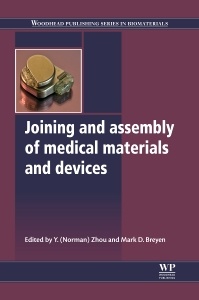Joining and Assembly of Medical Materials and Devices Woodhead Publishing Series in Biomaterials Series
Coordonnateurs : Zhou Y N, Breyen M D

Contributor contact details
Woodhead Publishing Series in Biomaterials
Part I: Fundamentals of joining and assembly in medical materials and devices
Chapter 1: Introduction to medical materials and devices
Abstract:
1.1 Introduction
1.2 The anatomy of interaction
1.3 Materials for drug delivery
1.4 The metrology of biocompatibility
1.5 Conclusion
1.6 Future trends
Chapter 2: Introduction to joining methods in medical applications
Abstract:
2.1 Introduction
2.2 Welding processes
2.3 Adhesive bonding
2.4 Examples of applications
Chapter 3: Microwelding methods in medical components and devices
Abstract:
3.1 Introduction
3.2 Materials challenges
3.3 Medical components and devices
3.4 Joint design and process selection
3.5 Testing and verification
3.6 Conclusion and future trends
Chapter 4: The effects of sterilization on medical materials and welded devices
Abstract:
4.1 Introduction to sterilization
4.2 Sterilization methods
4.3 The effects of sterilizing on different materials
4.4 The effects of sterilizing on welded joints
4.5 Selecting a suitable sterilization method
4.6 Conclusions
Part II: Joining and assembly of medical metals
Chapter 5: Micro-welding of shape-memory alloys
Abstract:
5.1 Introduction
5.2 Fundamentals of Nitinol shape-memory alloys
5.3 Micro-welding of NiTi
5.4 Future trends
5.5 Conclusion
Chapter 6: Joining of platinum (Pt) alloy wires to stainless steel wires for electronic medical devices
Abstract:
6.1 Introduction
6.2 Material properties
6.3 Material challenges in joining
6.4 The crossed-wire joint
6.5 Joining processes
6.6 Future trends
6.7 Conclusions
Chapter 7: Evaluating the corrosion performance of metal medical device welds
Abstract:
7.1 Introduction
7.2 Measurements of corrosion
7.3 Direct measurements of corrosion current
7.4 Considerations when gathering corrosion data
7.5 Test sample preparation
7.6 Instrumentation and equipment
7.7 Interpretation of data
7.8 Mitigations for weld corrosion
7.9 Future trends
7.10 Sources of further information
Chapter 8: Laser hermetic welding of implantable medical devices
Abstract:
8.1 Introduction
8.2 Hermetic-sealing techniques
8.3 Laser conduction welding
8.4 Focused laser beams
8.5 Laser welding parameters
8.6 Requirements for laser hermetic welds
8.7 Conclusion and future trends
Chapter 9: Validating hermeticity in welded metallic implantable medical devices
Abstract:
9.1 Introduction
9.2 The physics of leak rates
9.3 Measurement of leak rates – testing and verification
9.4 Determining leak rate based on helium content
Part III: Joining and assembly of medical plastics
Chapter 10: Overview of welding methods for medical plastics
Abstract:
10.1 Introduction
10.2 Fundamental processes of plastics welding
10.3 Medical plastics and weldability
10.4 Part and Joint Design
10.5 Processes with external heating
10.6 Processes with internal heating
10.7 Processes with implant welding
10.8 Potential impacts from other manufacturing processes
10.9 Special applications for welding of medical plastics
Chapter 11: Ultrasonic welding of medical plastics
Abstract:
11.1 Introduction
11.2 Ultrasonic-welding processes fundamentals
11.3 Ultrasonic-welding process parameters and control
11.4 Weldability
11.5 Horn design
11.6 Part and joint design
11.7 Process optimization
11.8 Other specific applications
11.9 Troubleshooting
11.10 Advantages and limitations
Chapter 12: Radio frequency (RF)/dielectric welding of medical plastics
Abstract:
12.1 Introduction
12.2 Dielectric heating fundamentals
12.3 Dielectric welding/sealing process description and process parameters
12.4 Key factors affecting the sealing process and seal quality
12.5 Weldability
12.6 Testing approaches for seals and the dielectric sealing process
12.7 RF welding process advantages, limitations and future trends
Chapter 13: Transmission laser welding strategies for medical plastics
Abstract:
13.1 Introduction
13.2 Advantages and limitations of laser welding
13.3 Process description
13.4 Main welding parameters and effects
13.5 Forms of equipment
13.6 Weldable materials
13.7 Joint designs
13.8 Monitoring and quality control
13.9 Applications
Chapter 14: Bonding strategies and adhesives for joining medical device components
Abstract:
14.1 Introduction
14.2 Designing a joint with adhesive
14.3 Mechanisms of adhesion
14.4 Adhesion promotion
14.5 Types of adhesives used in medical devices
14.6 Conclusion
Part IV: Joining and assembly of biomaterial and tissue implants
Chapter 15: Advanced metal–ceramic joining techniques for orthopaedic applications
Abstract:
15.1 Introduction
15.2 The challenges of joining metals to ceramics
15.3 Mechanical joining techniques
15.4 Direct and indirect bonded joining techniques
15.5 Active brazing joining techniques
15.6 Future trends
Chapter 16: Tissue adhesives and sealants for surgical applications
Abstract:
16.1 Introduction
16.2 Principles of tissue adhesives and sealants
16.3 Definitions and general considerations
16.4 Mechanisms of bonding
16.5 Application methods
16.6 Synthetic bioresorbable sealants
16.7 Commercial resorbable synthetic sealants and adhesives
16.8 Commercial resorbable bio-derived sealants and adhesives
16.9 Commercial biostable bio-derived sealants and adhesives
16.10 Commercial biostable synthetic sealants and adhesives
16.11 Conclusion
Chapter 17: Antibacterial adhesives for bone and tooth repair
Abstract:
17.1 Introduction to tooth repair
17.2 Introduction to bone repair
17.3 Future trends
17.4 Acknowledgment
Chapter 18: Testing bond strength: the case of dental biomaterials
Abstract:
18.1 Introduction
18.2 Rationale for bond strength testing
18.3 Classification of dental adhesive testing techniques
18.4 Behavioural adhesive tests
18.5 Structural adhesive tests
18.6 Future trends
18.7 Conclusion
Index
Mark Breyen is the Director, Core Technologies at Medtronic Inc., USA.
- Introduces joining methods in medical applications including microwelding and considers the effects of sterilization on the resulting joints and devices
- Considers the joining, assembly and corrosion performance of medical metals including shape memory alloys, platinum alloys and stainless steel wires
- Considers the joining and assembly of medical plastics including multiple welding methods, bonding strategies and adhesives
Date de parution : 05-2013
Ouvrage de 574 p.
15.5x23.2 cm
